
|
| |
1910–1924 | 1925–1926 | 1927–1930 | 1931–1943 | MORE RECENT
HARRY HOUDINI DIES AFTER OPERATIONS Magician, Conscious to Last, Loses Fight for Life in Detroit Hospital. DEATH DUE TO POISONING Playful Blow Given by Montreal Student as Test Caused Appendix to Break. Special to The New York Times.
Death was due to peritonitis, which followed the first operation, that for appendicitis. The second operation was performed last Friday. Like a newly discovered serum, used for the first time in Houdini’s case, it was of no avail. The chapter of accidents which ended fatally for the man who so often had seemed to thousands to be cheating the very jaws of death began early in October at Albany, N.Y. On the opening night of his engagement at a theatre there a piece of apparatus used in his “water torture cell” trick was overturned and struck him on the foot. Houdini called a physician from the audience, had his foot examined and then completed his performance. Afterward he went to a hospital and had the injured foot X-rayed. Appendicitis Follows Blow A bone was found to be partly fractured and Houdini was advised to discontinue his tour a few days and give prompt attention and plenty of rest to the injured foot. He declined to cancel his engagements, however, and did not miss a show. From Albany he and his company went to Schenectady. Houdini was suffering continuous pain and returned to Albany for several treatments. By the time he left Schenectady for Montreal his whole system was in a weakened condition. On Tuesday, Oct. 19, while in Montreal he addressed a class of students on spiritualistic tricks. During a reception following the address he commented on the strength of his stomach muscles and their ability to withstand hard blows without injury. One of the students without warning or giving time for Houdini to prepare struck him twice immediately over his appendix. He suffered no distress at the time but after he had boarded a train for Detroit he complained of pain. At first he attributed it to something he had eaten but as it increased he called in the company’s nurse, who in turn arranged by wire to have a physician meet the magician in Detroit. Dr. Leo Kretzka, a prominent physician, made a hurried examination and told the patient there were symptoms of appendicitis. He left it to Houdini to decide whether it would be advisable for him to appear that evening at the Garrick Theatre for the opening night of the show. Houdini would not disappoint his admirers. Looking back on that last performance, the large audience now realizes that the famous magician did his tricks under a great strain. He felt the grip of bonds he had never tested, the snap of a lock not forged by human hands. He was worried for one of the few times in his career and was plainly not up to his best form in some of his tricks. Conscious Until Death At his hotel after the performance the pain increased. The house physician and the best Detroit could furnish were called. Houdini was taken to Gray Hospital and the following afternoon underwent an operation for appendicitis. His removal from the hotel to the hospital was made at the suggestion of his family physician, William Stone of New York City, who had been notified by telephone of his friend’s condition. Until his death Houdini was conscious and his mind was keen and alert. The physicians who attended him say he was the best patient they ever had, and he helped them wonderfully. His mental attitude, combined with his unusual stamina, did much to prolong his life. According to statements made by the physicians, the playful punches he received in Montreal were the direct cause of Houdini’s death, for one of the blows caused the appendix to burst, saturating his system with poison. Streptococcus peritonitis, which developed soon after the operation last Monday, seriously complicated the case. This is a particularly virulent form of poisoning, and few cases are known to the medical profession where persons suffering from it have recovered. The body will leave Detroit for New York in a special car Monday evening, arrive in New York Tuesday morning about 9 o’clock. STAGE PAYS ITS TRIBUTES. Praises Houdini as Magician, Man and Friend.
B.M.L. ERNST, Vice President of the Society of American Magicians–“He was the greatest magician of his time and maybe of all times. He was absolutely unique, as his stunts were his own and not redecorated from something some one else had done. Whether it was a trick or an artifice, he had an ability to escape from various sorts of objects which no one else has been able to duplicate and which may die with him. He was head of the principal magic organization of England as well as of this country. He was the leading authority on magic literature and had the largest magic library in the world.” E. F. ALBEE, President of the Keith-Albee Circuit of Theatres–“Houdini was more than a national character; he was known and has appeared throughout the world. I had the great honor of being his first manager some thirty years ago when his work was as wonderful as during these past years when he became recognized as the peer among mystifiers and magicians. He was a man of extraordinary intelligence and tremendous physical strength. His whole life was ideal and his habits moderate, except with regard to his own work. He was always thoughtful and sensitive of fellow artists and a loyal member of the National Vaudeville Artists. We have never known any one who could equal him in his methods of theatrical presentations. I don’t believe there will ever be another just like Houdini. He was a prince of showmen. We shall all feel his loss.” MARK A. LUESCHEER, Former Manager of the New York Hippodrome–“Houdini was the greatest acting showman of this generation. He appreciated the value of publicity but he always obtained his publicity through legitimate and well thought out methods. He was a student, a philosopher, a model husband and an enduring friend. HENRY CHESTERFIELD, Secretary of the National Vaudeville Artists Club–“The theatrical profession has lost a showman whom it will be impossible to duplicate. He had an uncanny ability of selling his tricks in a way that made them appear entirely different from the tricks done by an one else, and for that reason he was of great value to his business.” ED WYNN–“On the theory that amusement is probably the most essential thing for the contentment of a community, Houdini’s death must be taken as one of the greatest losses of recent times. During our friendship of some twenty years, I have always found him a man whose ambition was solely to entertain the masses. He was fearless and undoubtedly the greatest master of magic.” R.H. BURNSIDE–“As a man he was a fine upstanding character. He would go out of his way to do things not expected of him to make his entertainment a success. I regret to hear of his death because the stage has lost a brilliant performer.” SAILING BARUCH–“Houdini was a very remarkable man and a very fine man. I am very sorry to hear of his death. We shall miss him very much.” Professional tribute to the memory of Houdini will be paid tonight by the council of his organisation, The Society of American Magicians, which has been called together for a special meeting at the offices of B.M.L. Ernst, 25 West Forty-third Street. SYRACUSE, N.Y., Oct. 31 (AP)–Howard Thurston, magician and for many years friend of Harry Houdini, in a statement made today, declared that in “the passing of Houdini, the world has lost a great mystifier and a useful, forceful character. “We were friends for thirty-five years, starting at the bottom together and climbing toward the top,” the statement said. “As a showman he was in a class with Barnum, in force of character he resembled Roosevelt.” HOUDINI WORLD FAMOUS No Locks Could Hold Him—Foe of Mediums Whatever the methods by which Harry Houdini deceived a large part of the world for nearly four decades, his career stamped him as one of the greatest showmen of modern times. In his special field of entertainment he stood alone. With a few minor exceptions, he invented all his tricks and illusions, and in certain instances only his four intimate helpers knew the solution. In one or two very important cases Houdini, himself, alone knew the whole secret. Houdini was born on March 24, 1874. His name originally was Eric Weiss and he was the son of a rabbi. He did not take the name Harry Houdini until he had been a performer for many years. Legend has it that he opened his first lock when he wanted a piece of pie in the kitchen closet. It is certain that when scarcely more than a baby he showed skill as an acrobat and contortionist, and both these talents helped his start in the show business and his later development as an “escape king.” Joined Circus at 9
In the ring at Coffeyville, Kan., a Sheriff tied him and then produced a pair of handcuffs with the taunt: “If I put these on you, you’ll never get loose.” Houdini, still only a boy, told him to go ahead. After a much longer stay in the cabinet than usual, the performer emerged, carrying the handcuffs in his free hands. That was the beginning of his long series of escapes from every known sort of manacle. For years he called himself the Handcuff King, a title discarded as he extended and elevated the range of his performances. From 1885 to 1900 he played all over the United States, in museums, music halls, circuses, and medicine shows, gradually improving his technique and giving up his purely contortionistic and acrobatic feats. In 1900 he made his first visit abroad, and in London his sensational escapes from handcuffs at Scotland Yard won him a six months engagement at the Alhambra. This was the first instance of his cleverly obtaining notoriety by a public or semi-public exhibition outside the theatre. No other showman, unless it was Barnum, knew better how to arouse the curiosity and amazement of the public in this manner. Escaped From Dozens of Prisons
In 1908 Houdini dropped the handcuff tricks for more dangerous and dramatic escapes, including one from an air-tight galvanized vessel, filled with water, locked in an iron-bound chest. And he would free himself from the so-called torture cell, his own invention. In this he was suspended, head down, in a tank of water. To thrill the general public he would hang from the roof of a skyscraper, bound in a strait-jacket, from which he would wriggle free to the applause of the crowd in the street below. Thrown from a boat or bridge into a river, bound hand and foot and locked and nailed in a box, doomed to certain death by drowning or suffocation, he would emerge in a minute or so, a free man, swimming vigorously to safety. In the last twenty years Houdini made many long tours, playing in nearly every important city in Europe, Asia, Africa and Australia. Occasionally others would attempt to imitate him, but his supremacy never was remotely threatened. An evidence of the deep impression his work made on the public mind is the fact that the Standard Dictionary now contains a verb, “houdinize,” meaning “to release or extricate oneself (from confinement, bonds, or the like), as by wriggling out.” A slang dictionary probably would list the expression, “do a Houdini,” with a similar meaning. Owned Valuable Library During the last few years Houdini had become internationally known as a tireless enemy and exposer of fraudulent mediums and all false claims in the field of spiritualism. He was a member of The Scientific American committee that investigated Margery, the Boston medium, whom he denounced in vigorous language. He was the author of “Spooks and Spiritualism,” “The Unmasking of Robert Houdin,” “Handcuff Secrets,” and “Rope Ties and Escapes.” At his home, 278 West 113th Street, he possessed a remarkable library, chiefly devoted to works on the theatre, to magic and the black arts. The collection has been valued at $500,000 and was insured for $350,000. Most of it has been willed to the National Museum at Washington. In July, 1926, Houdini was elected for the ninth successive time President of the Society of American Magicians. He also was President of the Magicians’ Club of London and a life member of the Authors’ Club of London. He married in 1894 Wilhelmina Rahner of Brooklyn. He was a member of St. Cecile Lodge No. 568, F. & A.M. BIZARRE EXPERIENCES TOLD BY HOUDINI Tricked Roosevelt on River of Doubt—Had Four “Close-Ups With Death” 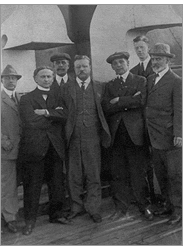 Few men could relate more interesting anecdotes and experiences than Harry Houdini. He was fond of telling how he beguiled the late Theodore Roosevelt and the late Victor Herbert on a voyage to Europe aboard the Imperator. Colonel Roosevelt had just returned from his exploration of the River of Doubt in Brazil. Few men could relate more interesting anecdotes and experiences than Harry Houdini. He was fond of telling how he beguiled the late Theodore Roosevelt and the late Victor Herbert on a voyage to Europe aboard the Imperator. Colonel Roosevelt had just returned from his exploration of the River of Doubt in Brazil.
“I was asked to give an entertainment,” Houdini would relate, “and the subject of spirit writing came up. A number of other well-known men were present, all of them having intelligence of a high order. Certainly it was not a credulous audience. I offered to summon the spirits and have them answer any questions that might be asked. “Roosevelt wanted to know if they could tell him where he had spent Christmas Day. I had a slate with the usual covering and in a few moments brought forth a map, done in a dozen different colors of chalk, which indicated the spot where he had been on the famous River of Doubt. That map was an exact duplicate of one that was to appear in his book which had not been published. I had never seen the map and, to make my case stronger, the name of W. T. Stead, the English spiritualist and writer who lost his life on the Titanic, was signed below the map in a handwriting which one man present instantly recognized as that of Stead. And I might add that I was unfamiliar with Stead’s signature. Colonel Roosevelt Dumfounded “Roosevelt was dumfounded. “ ‘Is it really spirit writing?’ he asked. “ ‘Yes,’ I replied with a wink.” Of course, Houdini never explained how the trick was done, at least to the public. The magician tried his hand at the medium business in his early days in Kansas and used to tell in this wise how he prepared for one of his first seances: “I had gone around to the cemeteries and read all of the inscriptions on tombstones, looked over a few birth and death records and acquired a lot of information from the gossips. When the time arrived for my act I puzzled the crowd by giving particulars of births and deaths in half of the families of the town. Gradually I worked up to a climax, exclaiming: “ ‘Now what do I see? What is this coming before me? Why, it is a man—a black man. He’s lame—and his throat is cut from ear to ear. Who is this man?—why, I know him; he is Efram—Efram Alexander.’ The negroes at the meeting deserted in a body with shrieks because they recognized a negro who had been killed recently.” For thirty-three years Houdini tried to solve the mysteries of spiritism. He told friends he was ready to believe, was anxious to believe, because he would find joy in proof that he could communicate with his father, mother and friends who had passed on. He had agreed with friends and acquaintances, numbering hundreds, that the first to die was to try to communicate from the spirit world to the world of reality. Fourteen of those friends had died, but none had ever given a sign, he said. Anxious for Spirit Messages
“Another thing that seemed almost supernatural to me occurred at the death of William Berol, a mystifier and close friend of mine. We had worked together on the stage and had a private telegraphic code for signaling messages. We made a compact that the first who died should use that code to communicate with the other. At his deathbed I held Berol’s hand. He had been unconscious for some time. He showed no outward signs of a return to consciousness. His eyes remained closed. But just as he passed away I could feel his hand making a faint pressure upon mine. That was repeated at intervals and I could recognize that the man who seemed unconscious and at death’s door was talking to me in code. I received and understood his message. But I hold it sacred and have never repeated it.” Houdini counted that he had had “four close-ups with death” in his career of more than thirty years as a mystifier. The closest was in California, where he risked his life on a bet and not as a public performance. Seven years ago in Los Angeles he made a wager that he could free himself from a six-foot grave into which he was to be buried after being manacled. He had first accustomed himself to the sensation of burial by more shallow interments. Scare Nearly Cost Life
“The next time I am buried it will not be alive if I can help it.” But Houdini did later permit himself to be “buried alive” in a hermetically sealed casket of zinc which was submerged in a pool at a New York hotel. He remained there for more than an hour and a half, bettering the record of the Egyptian fakir, Rahmin Bey. When there was talk of a “return” submergence contest between the magician and the fakir, Houdini made preparations to defend his title with all the care that he was wont to exercise in working up his baffling feats. He began to cancel engagements that conflicted with a period of training he mapped out for himself. “I can’t dine with you this afternoon at 6 o’clock because I have to go down at 5,” said Houdini to a friend. Houdini went “down” or submerged in his sealed casket for half an hour daily. Friends of the showman said yesterday that he had developed a dislike for being called by his first name, Harry. He always wished to be called Houdini and disliked the prefix, Mr. This article is reproduced here only for educational purposes. Please do not copy the text or accompanying images for commercial use.
|
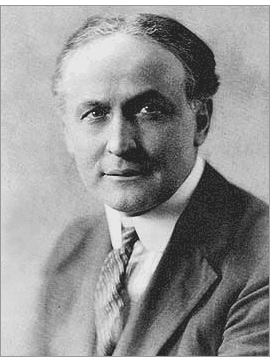 DETROIT, Oct. 31–Harry Houdini, world famous as a magician, a defier of locks and sealed chests and an exposer of spiritualistic frauds, died here this afternoon after a week’s struggle for life, in which he underwent two operations.
DETROIT, Oct. 31–Harry Houdini, world famous as a magician, a defier of locks and sealed chests and an exposer of spiritualistic frauds, died here this afternoon after a week’s struggle for life, in which he underwent two operations.
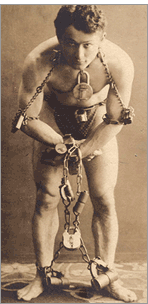 The stage and the world of magic and magicians joined yesterday in paying tribute to Houdini, not only as the leader in his particular field of entertainment but as a unique figure whose like will probably not be seen again for some time. The following tributes were voiced by persons with whom he had been intimately associated:
The stage and the world of magic and magicians joined yesterday in paying tribute to Houdini, not only as the leader in his particular field of entertainment but as a unique figure whose like will probably not be seen again for some time. The following tributes were voiced by persons with whom he had been intimately associated:
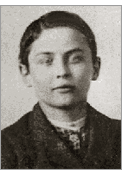 At the age of 9 Houdini joined a traveling circus, touring Wisconsin as a contortionist and trapeze performer. The Davenport brothers were then famous, doing the first spiritualist work ever seen in this country. They would ring bells while bound inside a cabinet and would agree to free themselves from any bonds. This inspired Houdini to a somewhat similar performance. Standing in the middle of the ring, he would invite any one to tie him with ropes and would then free himself inside the cabinet.
At the age of 9 Houdini joined a traveling circus, touring Wisconsin as a contortionist and trapeze performer. The Davenport brothers were then famous, doing the first spiritualist work ever seen in this country. They would ring bells while bound inside a cabinet and would agree to free themselves from any bonds. This inspired Houdini to a somewhat similar performance. Standing in the middle of the ring, he would invite any one to tie him with ropes and would then free himself inside the cabinet.
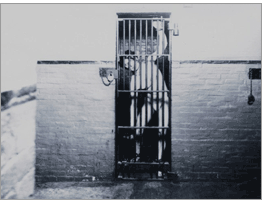 During a six-year tour of the Continent he escaped from dozens of famous prisons. In the Krupp plant at Essen he met the challenge of the workmen and freed himself from expertly constructed shackles before 70,000 persons. He returned to America to find his fame greatly increased and a newly organized vaudeville ready to pay him many times his old salary. He continued his prison escapes over here and in January, 1902, broke from Cell 2 in the Federal prison at Washington, the cell in which Guiteau, President Garfield’s assassin, had been confined.
During a six-year tour of the Continent he escaped from dozens of famous prisons. In the Krupp plant at Essen he met the challenge of the workmen and freed himself from expertly constructed shackles before 70,000 persons. He returned to America to find his fame greatly increased and a newly organized vaudeville ready to pay him many times his old salary. He continued his prison escapes over here and in January, 1902, broke from Cell 2 in the Federal prison at Washington, the cell in which Guiteau, President Garfield’s assassin, had been confined.
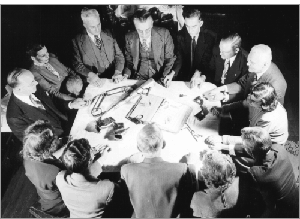 “One of those pledges,” Houdini once told, “was with my secretary, John W. Sargent, one of those who exposed Palladino in this city. Our relations were most intimate. He died and I have not heard from him. Such an agreement I made with both my parents. They died and I have not heard from them. I thought once I saw my mother in a vision, but I now believe it was imagination.
“One of those pledges,” Houdini once told, “was with my secretary, John W. Sargent, one of those who exposed Palladino in this city. Our relations were most intimate. He died and I have not heard from him. Such an agreement I made with both my parents. They died and I have not heard from them. I thought once I saw my mother in a vision, but I now believe it was imagination.
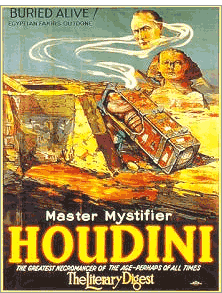 “The knowledge that I was six feet under the sod gave me the first thrill of horror I had ever experienced,” Houdini was wont to say in telling of his hair-raising escape. “The momentary scare, the irretrievable mistake of all daredevils, nearly cost me my life, for it caused me to waste a fraction of breath when every fraction was needed to pull through. I had kept the sand loose about my body so that I could work dexterously. I did. But as I clawed and kneed the earth my strength began to fail. Then I made another mistake. I yelled. Or, at least, I attempted to, and the last remnants of my self-possession left me. Then instinct stepped in to the rescue. With my last reserve strength I fought through, more sand than air entering my nostrils. The sunlight came like a blinding blessing, and my friends about the grave said that, chalky pale and wild-eyed as I was, I presented a perfect imitation of a dead man rising.
“The knowledge that I was six feet under the sod gave me the first thrill of horror I had ever experienced,” Houdini was wont to say in telling of his hair-raising escape. “The momentary scare, the irretrievable mistake of all daredevils, nearly cost me my life, for it caused me to waste a fraction of breath when every fraction was needed to pull through. I had kept the sand loose about my body so that I could work dexterously. I did. But as I clawed and kneed the earth my strength began to fail. Then I made another mistake. I yelled. Or, at least, I attempted to, and the last remnants of my self-possession left me. Then instinct stepped in to the rescue. With my last reserve strength I fought through, more sand than air entering my nostrils. The sunlight came like a blinding blessing, and my friends about the grave said that, chalky pale and wild-eyed as I was, I presented a perfect imitation of a dead man rising.